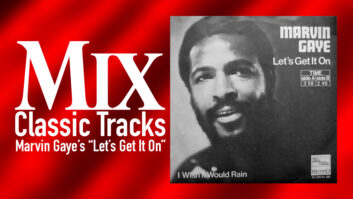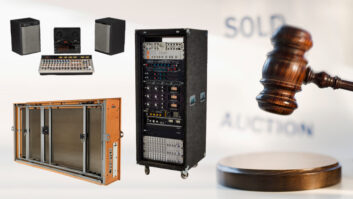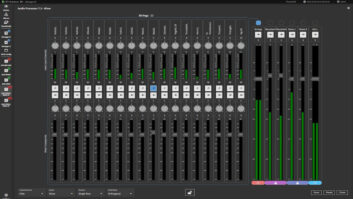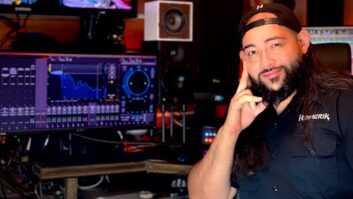Capturing a LegendAs the music of Ginger Baker and the DJQ2o (Denver Jazz Quintet To octet) was being released to the world, praised in Down Beat and touted as recording of the month in Stereophile, Ginger Baker was packing his polo ponies and heading for South Africa. The mercurial drummer-known for his groundbreaking work with Cream in the ’60s and subsequently on numerous jazz and fusion recordings of his own groups and by others-finally gave in under increased pressure from INS and IRS officials and split, leaving one of his best albums, Coward of the County, in his wake.
For engineer Danny Kopelson and musical director/trumpeter Ron Miles, Baker’s parting shot, recorded at Colorado Sound Recording, was a memorable session to be aboard. The Denver-based band was well-rehearsed, and Miles wrote several songs around Baker’s strengths, including the 6/8 “Ginger Spice.” “Ginger liked these kind of Afro grooves, and I knew that he had lived in Africa and played with Fela and stuff,” says Miles. “I know that Public Image Ltd. record he plays on with Tony Williams and the big beat stuff. But this guy can play brushes.”
Baker navigates the shifting meters of Miles’ “Jesus Loves Me” with a sure hand. “To actually get comfortable enough to improvise while the meters are constantly shifting-that’s the real tricky thing,” the composer says. “I write music without any bar lines, then I figure out what the cadence and phrasing is. The music should dictate the phrasing. once Ginger understood that we weren’t just trying to be nerdy, then he was able to get with that tune.”
The DJQ2o includes tenor saxman Fred Hess, bassist Artie Moore and Eric Gunnison on piano. organist Shamie Royston, pedal steel player Glen Taylor and guitarist Todd Ayers are featured on different tracks, and at Atlantic Records’ request, James Carter was added to the session on bass clarinet and bari. “Then it was just figuring out who would play on what,” says Miles. “I would make demo tapes here in the house of me playing, drive around in my car listening to them and then write something else for the next rehearsal.”
Not surprisingly, capturing Baker’s notoriously huge drum sound presented quite a challenge to Kopelson. “Ginger is such a power drummer and really toms-concentrated,” he says. “I knew from jazz things and the old Cream days that he likes using those toms. I was prepared for the fact that he’s going to have a loud kit, given that in mind. I’ve never known him to be dynamically on the soft side, though he can. So knowing it was going to be straight to 2-track, the question was how to get the live feel with some control. Eventually we found a combination where Ginger could be boothed and still be on the main floor with everybody within eyesight. We changed things around a couple times and found something that worked for him, where he could feel like he was in proximity to everybody else but with a little bit of control from isolation. That was a big help-then I could get off the kit a little bit and let it breathe a little, as opposed to really having to choke it to be able to control it. I could bring the [Cole] overheads up without having to necessarily worry about a lot of leakage from guitars and things.
“He was in a booth with just enough attenuation so that I could EQ drums or any other instruments. If you back the drum overheads off, then you’ve got piano leakage in the drum overheads. You go to EQ the drum overheads and it affects the piano sound and vice versa; the cymbals are leaking into the piano. And if the piano’s across the room then you have delay, and you get into a real washed-out sound because the distance causes the delay. We eventually got everything in a sweet location for it to go down live, and then we got the control with Ginger by a little bit of isolation.
“We were going to have to put Ginger off in no-man’s-land to give him a big room to spread out with room mics, and that wasn’t really working for him,” the engineer continues. “Then we came to this understanding where we’d only use half the studio, which brought everybody into a tighter proximity. And luckily this iso booth had a real good open drum sound and didn’t telegraph the size of the booth, given a little bit of reverb help.”
Baker’s tom-toms got special attention from Kopelson. “What I tend to do, especially with a drummer like Ginger, is use compression in summing the tom. I basically create a stereo bus to control the toms, because he is so dynamic with the toms. I would take the output of the toms in their pan and use a little bit of stereo limiting compression, which also helps to add a presence to them a little bit, will allow it to speak as well as the snare drum does. A little bit of compression and limiting will help the toms sit up in the drum kit and speak as well as any other part of the drums. That’s part of what the job of straight-to-2-track is, being able to use some of those mixing techniques at the time of recording that will allow it to fit into the tape properly. You don’t get another chance to lower the level or do those things. It’s not just recording, and it’s not just mixing; it’s a hybrid of both. It’s fascinating when you think that some of your favorite jazz records were done that way. Performance music going down, and if it’s not right you make another performance instead of trying to patch something in that doesn’t feel right. It is what it is. That comes across on record very differently from piecemeal work. I like that aspect of flying by the seat of your pants, ‘What’s it going to be like this time?’ It’s exciting.
“I had to stay on my toes on a tune-by-tune basis,” Kopelson continues. “I got a few run-downs to be able to compensate gains on louder or quieter tunes. They were very well-rehearsed, which always worries me in a situation like that. They’re ready to just bounce on to the next tune, and sometimes you can be caught short on certain adjustments you’d like to make. But I think things flowed very smoothly as far as working from tune to tune and making the necessary adjustments on Ginger or anybody else. Ron was really interactive in helping me get ready for the next thing, giving me what I needed to give them what they needed. I needed to know what the dynamic was. If we were going from a hard-hitting tune to a ballad, I needed to know if it had any crescendos in it or if it was low-key. You don’t want to make the change if somewhere in that tune they’re just going to be back up in intensity. If you’re in the wrong place with the wrong tune, you’ve got a great performance with recording problems like saturation or distortion, or if you’re not open enough, you’ve got a noisy low-level tape. So the job is just balancing and optimizing things.”
Kopelson wound up using the studio’s Euphonix console as well as renting some mic pre’s for the session. “With some of the modifications that are made on the Euphonix, I think it’s really analog on the front end,” he says. “But not being that familiar with it, I wanted to have some things that I knew and liked. So we did rent a few preamps, and I brought out some Avalon stuff. They make these units now that have a preamp, EQ and compressor in them, which I love the sound of-the 737 and the 737sp. We also rented some VR72 and 76 pre’s, a couple APIs and a couple Focusrite pre’s. on some stuff, I bypassed the board, and on some, I did use the front end of the board. I was surprised with how warm it sounded; I really hadn’t anticipated that there would be that much fat and warmth to those things. I didn’t have enough pre’s to go all the way through the session, so I had to pick and choose carefully what I was going to use them on. And I used the board for the rest.”
They recorded it at 30 ips with no Dolby. “We went straight to half-inch, and we used CD backup, and we got everything as it went down,” Kopelson says.
Kopelson chose a U47 for the bass. “Basses are like people, everybody has a different personality,” he says. “With one mic I like to compromise from the F hole in the bridge and see if I can’t get a little string snap in addition to some resonance from the body and try to get the definition that way. Artie’s bass gave us everything we needed. If anything, it’s a little bit articulation-shy in some cases, but I go for that Paul Chambers-sound and I think Artie does too.” Kopelson used a 47 on the trumpet and a 48 on James Carter’s bari and bass clarinet.
Kopelson gives credit for the comfortable working conditions to musical director Miles: “Ron was really helpful in integrating everybody into the teamwork aspects. I can’t say enough about how multitalented he is, both as a musician-arranger-composer and people person. It was really a pleasurable experience. He kept everybody upbeat, and Ginger was really excited with what Ron had helped pull together and how it dovetailed with his ideas. Most of the time Ginger was real upbeat. I had heard stories of him being sort of cranky and obstreperous-nothing drastic. But short of trying to make it all sugar and spice, he seemed to really be having fun.”







